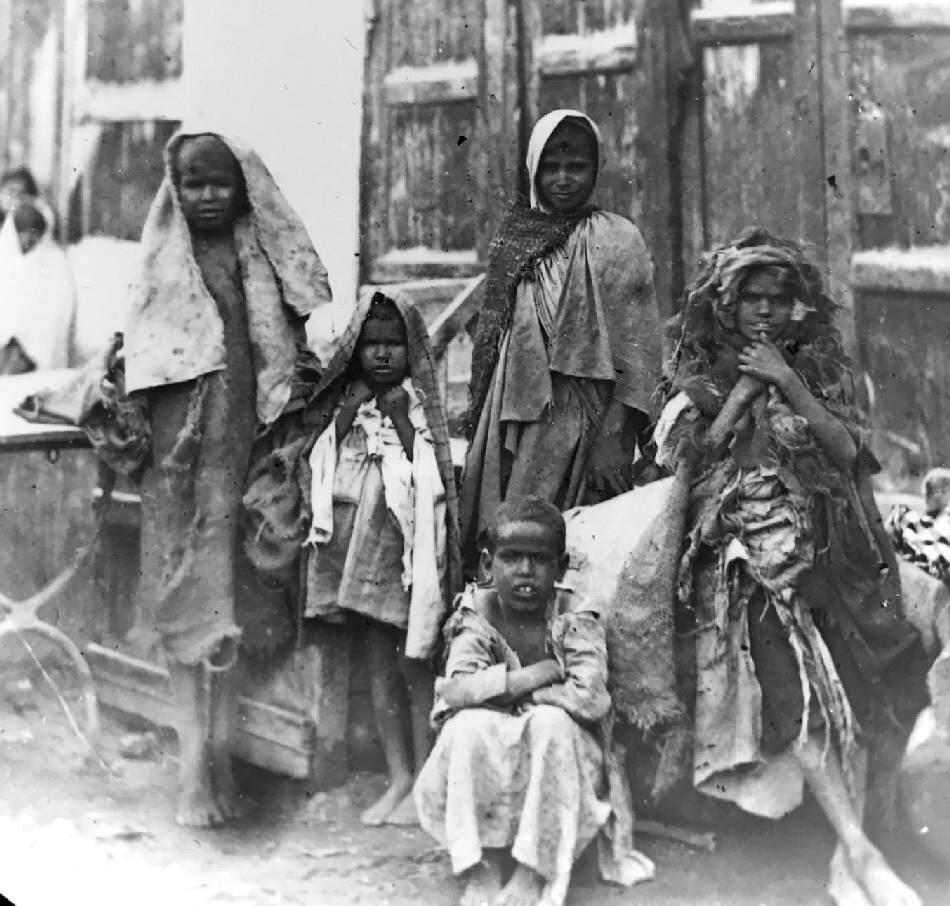
Arabian Economy: Ottoman Era (1517-1918)

Figure 1.--This magic lantern glass photo slide shows a group of Bedouin children in Arabia. It is undated, but would hve been taken during the late-19th or early-20th century. It illustrates the poverty endemic throughout Arabia during the Ottoman era.
|
|
The Ottoman Empire seized control of the Arab lands as a result of the Ottoman–Mamluk War (1516–17). The Ottomans previously had influence in the Arab lands, but not control of the major centers. Ottomam victory in the War led to the fall of the Mamluk Sultanate and the subsequent incorporation of the Levant, Egypt and the Hejaz as Ottoman provinces. The War transformed the Ottomans from a realm at the perifery of the Islamic world (Anatolia and the Balkans) to a huge empire including all the traditional lands of Islam, including the cities of Mecca, Cairo, Damascus, and Aleppo. And possession of Mecca meant that the Ottoman Sultan could lay claim to be the supreme Islamic religious authority. The Arabian Peninsula itself was of only limited interest to the Ottomans. The reason for this was that most of the Peninsula was very poor. It would cost more to administer the Peninsula or control the tribes than any value which could be obtained. There was no industry and little or no manufacturing. And in the pre-indudtrial era, wealth was primarily generated by agriculture. But throughout the vast expanse of the Peninsula there was very little surface water and extremely limited precipitation meaning that agriculture was also very limited. The sultanantes such as Oman and the small Persian Gulf ports were of some interest because of trade. And the Hejaz or Western Province with Mecca and Medina was of interest for religious reasons. The Ottoman Sultans were able to established themselves as the highest authority in Islam because of a combination of military power and possesion of the Hejaz. Control of the Hejaz with Mecca also had an economic dimension wiuth the annul influx of Islamuc pilgrims. And the Koran in contrast to the Western idea of separation of church and state envisions a unity between religion and the state. This meant that control of Mecca was vital. Thus outside of Mecca and the trade routes, the Ottomans showed no interrest in Arabia. Arabia in ancient times was of some economic value because of trade routes. The Arabian trade routes by the time the Ottomans seized the area (16th century) with an eye on the Indian Ocean. The Portuguese ended Ottoman/Arab control of the Indian Ocean at the Battle of Diu (1509). Diu meant that trade routes through Arabia no longer connected East and West which as a result of the Western controlled maritime trade was a major trade route. There was, however, some limited trade between India and East Africa and the Ottoman Empire. The Western navies which opened up trade with the East (China, the East Indies, and China) made no effort to interfere with this trade conducted by the small Arab dhows in the Indian Ocean. The only exception was when the Royal Navy began to end one element in that trade--the Indian Ocean slave trade. The only important Ottoman economoic development project we know of was the Hejaz Railway to Mecca whch the Ottomans built just before World War I.
CIH

Related Chronolgy Pages in the Boys' Historical Web Site
[The 1880s]
[The 1890s]
[The 1900s]
[The 1910s]
[The 1920s]
[The 1930s]
[The 1940s]
[The 1930s]
[The 1940s]
[The 1950s]
[The 1960s]
[The 1970s]
[The 1980s]
Navigate the Children in History Website
[Return to the Main Arabian economy page]
[Return to the Main Saudi page]
[Return to the Main country page]
[Return to the Main Middle Easterm country economy page]
[Return to the Main Middle Eastern history page]
[About Us]
[Introduction]
[Biographies]
[Chronology]
[Climatology]
[Clothing]
[Disease and Health]
[Economics]
[Geography]
[History]
[Human Nature]
[Law]
[Nationalism]
[Presidents]
[Religion]
[Royalty]
[Science]
[Social Class]
[Bibliographies]
[Contributions]
[FAQs]
[Glossaries]
[Images]
[Links]
[Registration]
[Tools]
[Children in History Home]
Created: 8:12 PM 7/13/2017
Last updated: 8:12 PM 7/13/2017



